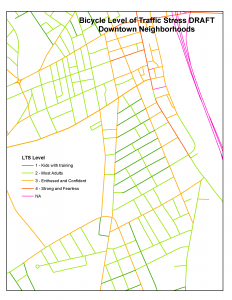LeTS Roll!
Help more people get out and ride in Central New Hampshire! Help us create Level of Traffic Stress Maps to show how to get the most out of road enhancements.
Leader
Tim Blagden
Location
2 Whitney Rd. Suite 11 Concord, NH 03301
About the project
“Example of a low stress street” by Ann <https://www.flickr.com/photos/81325557@N00/> & licensed under by-nc-nd/2.0 <https://creativecommons.org/licenses/by-nc-nd/2.0/>
What if you could help make it safer for you and your friends to go more places by bicycle? You can, by supporting LeTS Roll! By using the Minetta Transportation Institute method of mapping the Level of Traffic Stress (LeTS) that bicyclists experience on our roads, we can help planners and advocates identify a few key investments that will make a big difference in how safe you feel while bicycling. When you feel safer, you’ll ride more, and getting more people riding actually does increase the safety for all bicyclists by making drivers more aware.
Think of the last trip you made to work, home, school, or your favorite relaxation spot. Now imagine taking that trip on a bicycle. Parts of it probably seem safe enough on a bicycle. Those are the low stress bits. But there are probably other parts where you’d say “No way! It’s too dangerous to ride a bike there.” Those are the high stress bits. If any part of your trip is on a high stress road, you probably won’t go by bicycle. Those high stress areas effectively surround the low stress areas, turning them into islands.
Our project will map the stress levels of our streets and roads to highlight the comfortable areas and the scary sections. That lets us see where improvements can be made that will make you feel safe enough to make your trip on a bicycle. The Minetta Transportation Institute has conducted research that shows stress mapping is the most cost-effective method for making our roads safer and getting more people out riding their bikes.
A picture may be worth a thousand words, but a good map that brings people together and helps reveal solutions is worth a million. Please donate now to help get more people riding more often.
The Steps
· Raise enough money by March 10, 2015, to hire a summer intern to collect data on streets: e.g. lane widths, speed limit, parked cars, etc.
· Use data to assign stress levels to each street in the project area.
· Create maps that use color to show stress levels. This makes low stress networks and high stress obstacles easy to identify.
· Show municipal leaders and bike advocates how to use the maps.
· Maps allow communities to identify road projects that have the biggest return on investment in creating connected low-stress networks.
Why we‘re doing it
The biggest reason more people aren’t out riding bikes is fear. If we can help make bicycling less scary by helping communities identify where to make the best investments, more people will ride. And as studies have shown, there really is safety in numbers.

